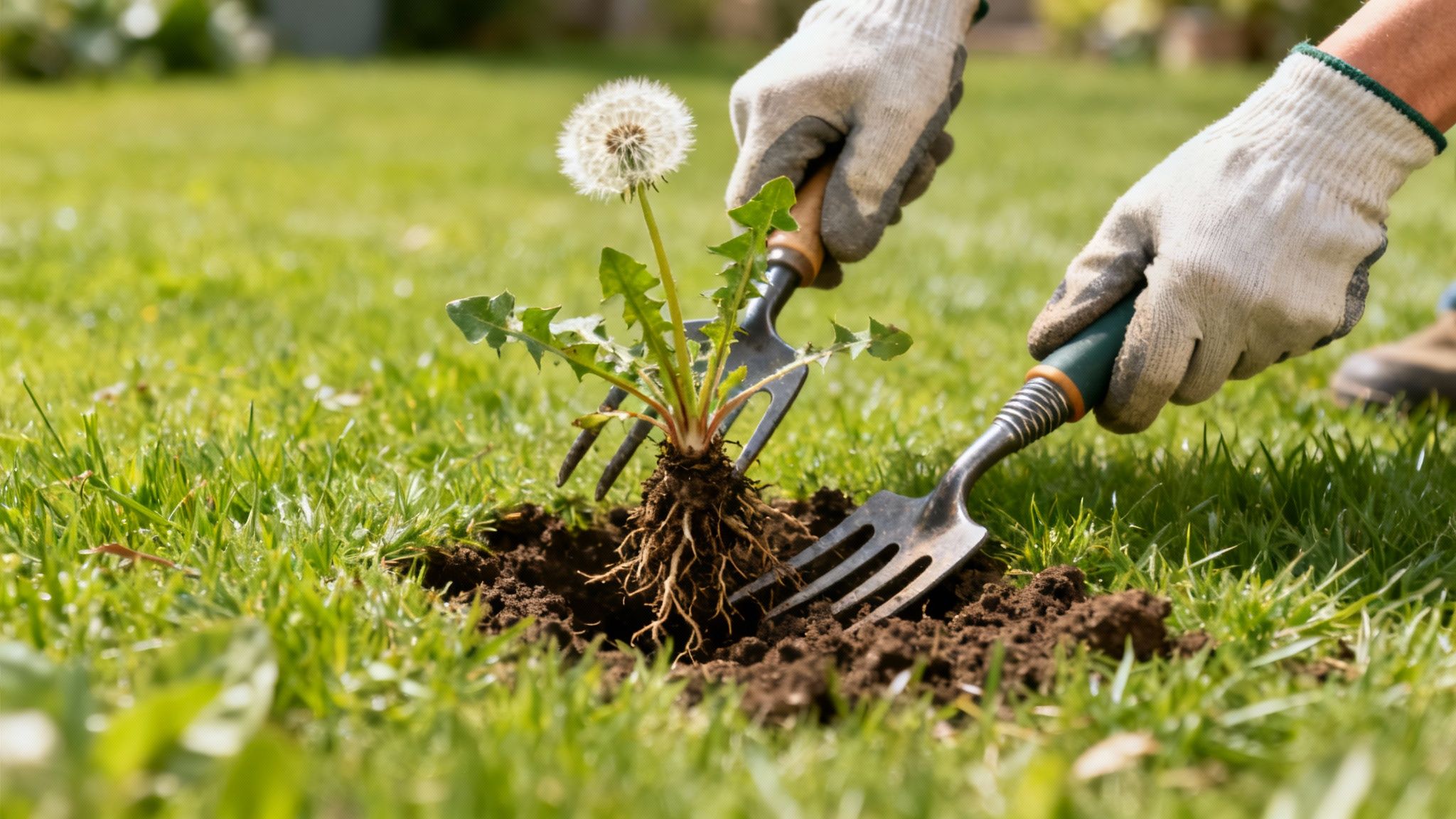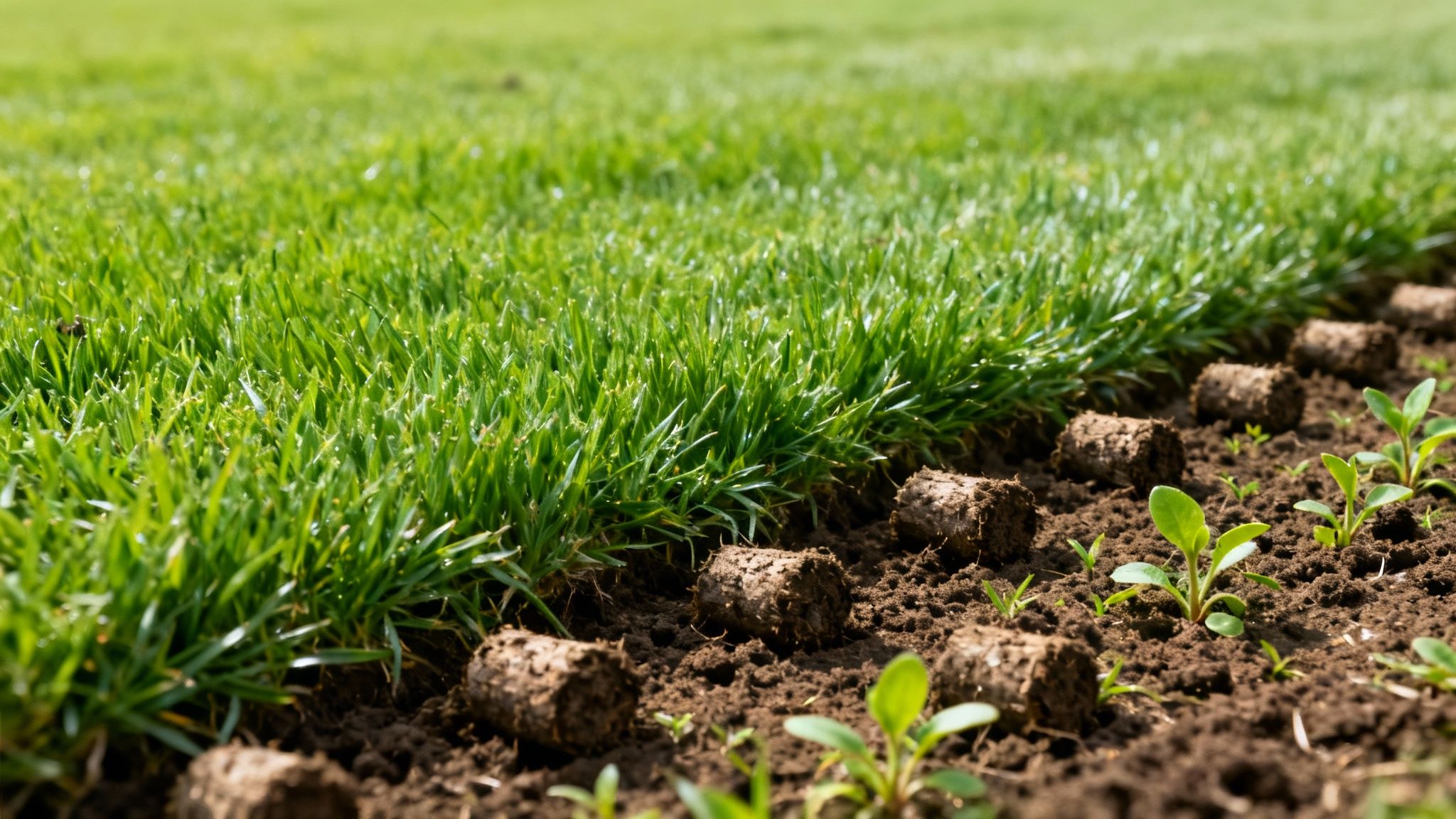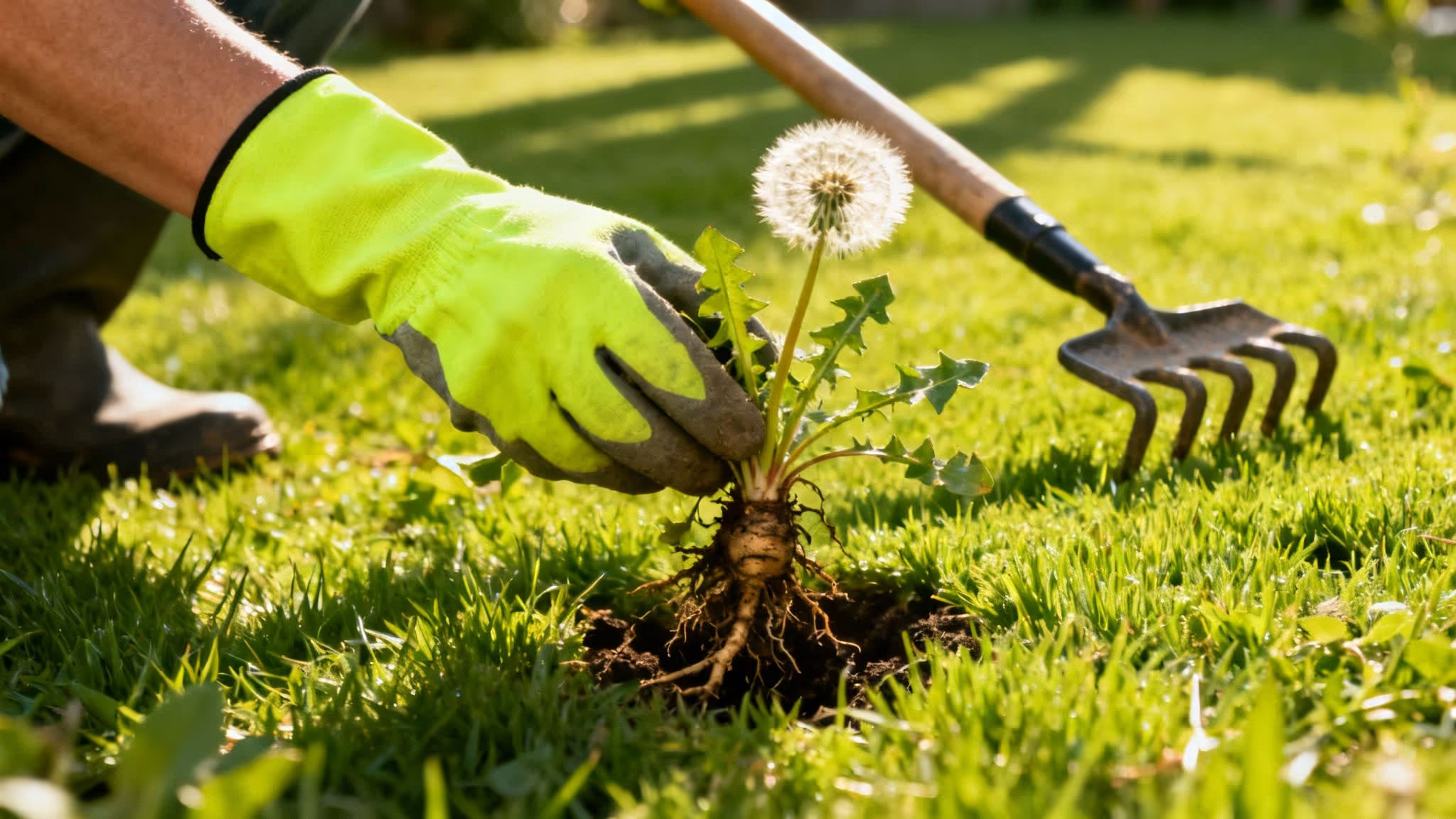Getting weeds out of your lawn for good all starts with one simple but absolutely vital step: knowing what you’re up against. Figuring out whether you’re dealing with a deep-rooted dandelion or a sneaky, spreading clover is the key to picking a method that actually works. A little bit of knowledge at the start saves a massive amount of time, effort, and frustration down the line.
Know Your Enemy: Identifying Common Lawn Weeds
Before you can win the war on weeds, you’ve got to get to know the enemy. A weed isn't just a weed; each type has its own game plan. From its root system to its life cycle, these characteristics are clues that tell you the best way to get rid of it for good. Just yanking every unwanted plant out the same way can, believe it or not, often make the problem much worse.

Take the classic dandelion, for instance. If you just pull the top, you'll almost always leave its long taproot behind, and it'll just regrow, often stronger than before. On the flip side, some shallow-rooted annuals can be dealt with in seconds. This is exactly why a bit of detective work is your most powerful tool in the fight for a beautiful lawn.
To help you get started, this table covers some of the usual suspects you'll find in UK lawns.
Quick Guide to Common UK Lawn Weeds
Use this table to quickly identify common weeds in your lawn and find the most effective approach to remove them.
Hopefully, that gives you a clearer picture of what might be popping up in your grass. Now, let's break down those weed categories a little further.
Broadleaf Weeds vs Grassy Weeds
The first big split in the world of weeds is between broadleaf and grassy types. Just knowing this one thing can point you in the right direction, especially if you’re thinking about using a chemical treatment.
- Broadleaf Weeds: These are usually the easy ones to spot because, well, they don't look like grass. Think of dandelions with their sunny flowers, clover with its iconic three-leaf pattern, and the common lawn daisy. Their leaves are typically broad and flat.
- Grassy Weeds: These are the undercover agents. They’re much trickier to identify because they try to blend in with your lawn. Culprits like annual meadow grass often just look like a slightly different shade of green or grow in a clumpier way than your turf.
Why does this matter so much? Because selective herbicides are cleverly designed to target broadleaf weeds while leaving your actual lawn grass unharmed. If you accidentally grab a non-selective weedkiller, it will kill everything it touches, leaving you with ugly bare patches.
Annuals and Perennials
The next bit of intel you need is the weed’s life cycle. Is it a short-term visitor or a permanent resident trying to move in?
An annual weed does everything—sprouts, flowers, and drops new seeds—all in one growing season. They spread quickly but often have shallow roots, which makes them much easier to pull out.
A perennial weed, on the other hand, is in it for the long haul, living for two years or more. These troublemakers build up deep, stubborn root systems (like that dandelion taproot) that act like a battery, storing energy so they can come back year after year. Getting rid of these requires a really thorough approach to make sure every last bit of root is gone.
Here’s a classic mistake: treating a perennial like an annual. If you just pull the top off a thistle or a dock, you’re basically just giving it a haircut. It will, without a doubt, grow back from the root left behind in the soil.
Knowing when weeds are at their weakest is also a game-changer. For a bit more insight into timing your garden jobs perfectly, you can check out resources like this fantastic UK planting calendar, which gives a great overview of what to do and when. Hitting weeds when they’re most vulnerable makes your job a whole lot easier.
The Hands-On Method For Weed Removal
Sometimes, the best way to get rid of weeds is just to get your hands dirty. Pulling weeds manually is a straightforward, chemical-free approach that gives you immediate results and a real sense of satisfaction.
There's nothing quite like yanking a stubborn weed out, root and all. It’s the most direct way to stop it from coming back, saving you hours of frustration down the line.

The trick is to get the entire root system. This is absolutely critical for perennial pests like dandelions and thistles, which can easily regrow from even a tiny piece of taproot left behind.
Of course, you have to be careful. If you pull too aggressively, you can tear up your turf, leaving bald patches that are a prime invitation for new weeds to move in.
Tools That Save Your Back
Having the right tool for the job makes a world of difference. It turns a chore into a much more manageable task.
- A stand-up weeder is a lifesaver for your back. It uses leverage to pop deep taproots out cleanly without you having to bend over.
- The classic fishtail fork is perfect for precision work, sliding under shallow-rooted broadleaf weeds for a quick removal.
- A handheld claw is great for loosening compacted soil around a weed, allowing you to lift it gently and protect the surrounding grass.
Timing is everything. Try to tackle weeding after a light rain when the soil is moist. The weeds will slide out much more easily, roots and all. This not only makes the job quicker but also reduces the chance of roots snapping off and re-sprouting.
Many seasoned gardeners swear by their long-handled weeders. One person mentioned clearing 50 dandelions in less than 10 minutes with one. It really can be that effective.
"It felt like a magic wand for weeds without bending over," says Spruce Collective member Janet.
Manual removal is fantastic for small patches or when you catch an infestation early, before the weeds have had a chance to set seed and spread. Getting to them promptly also stops them from developing extensive underground networks that are a nightmare to deal with later on.
- Pros: You get immediate, satisfying results, and it's completely safe for pets and children. No chemicals involved.
- Cons: It can be tough work on a large lawn, and you risk a sore back if you don't use the right tools or maintain good posture.
Once you're done, keeping your tools organised makes life easier for the next time. For tips on keeping your shed tidy, check out our guide on garden tool storage ideas. A simple trick is to keep your weeder right by the door so you can grab it for a quick five-minute session whenever you spot a new invader.
When To Choose Manual Removal
So, when is pulling by hand the best option? It’s ideal for smaller lawns or newly seeded areas where you want to cause as little disturbance as possible. It's also the go-to method for picking off isolated weeds or when you're trying to protect pollinator-friendly plants along the edges of your lawn.
Here are a couple of pointers:
- Hand-pull annual weeds before they flower and set seed to stop the next generation in its tracks.
- For perennials, wait until after it rains. The roots will release their grip on the soil, making them much easier to pull out completely.
For the best results, combine manual weeding with a good organic mulch. This helps to suppress any new seedlings and will keep your lawn looking immaculate all season long.
Natural and Organic Weed Control Solutions
If you want a lawn that’s safe for children, pets, and local wildlife, you don't have to just accept a weedy patch of grass. Going organic isn't just about ditching chemicals; it's about building a healthier, more resilient garden right from the soil up.

This philosophy is gaining ground all over the country. The UK is making a concerted effort to move away from a heavy reliance on pesticides, with the National Action Plan aiming to dial back their environmental impact. This isn't a new idea—we've seen big reductions over the past few decades—but the push continues. You can read more about these green initiatives in the UK's official plan for a more sustainable future on GOV.UK.
The Power of Prevention
Your best organic defence is, without a doubt, a thick and healthy lawn. A dense carpet of grass leaves precious little room—or light—for weed seeds to even think about germinating. This is the absolute foundation of natural weed control.
Think of your lawn as a living, breathing mulch. When your grass is thriving, it simply bullies out any potential intruders, hogging all the sunlight, water, and nutrients. Weeds don't stand a chance when they can't get a foothold.
The most effective long-term solution for removing weeds from grass is to create an environment where they struggle to grow in the first place. Prevention is always better than cure.
Natural Treatments for Existing Weeds
Of course, even the most perfect lawn will get the odd gatecrasher. When that happens, there are some really effective, eco-friendly ways to spot-treat them. The key thing to remember is that many of these are non-selective, which is a fancy way of saying they’ll kill any plant they touch—including your prized grass.
Here are a couple of my go-to methods for targeted attacks:
- Boiling Water: This is as simple as it sounds. Pouring a kettle of boiling water directly onto a weed, especially one peeking through a patio crack, will scald and kill it instantly. It's brutally effective but requires a steady hand to avoid damaging your lawn.
- Horticultural Vinegar: A quick spray with horticultural vinegar (which is much stronger than the stuff you put on your chips) will burn the leaves of broadleaf weeds. Like boiling water, though, it’s a scorched-earth tactic. Be incredibly precise, as any overspray will leave a brown, scorched patch on your grass.
Pre-Emergent Solutions
If you prefer to get ahead of the problem, corn gluten meal is a fantastic organic pre-emergent. Spread it over your lawn in early spring, and it gets to work by stopping the roots of sprouting seeds from developing properly. It won't do anything to weeds that are already established, but it's a great way to prevent a whole new wave from showing up.
Timing is everything here. You need to apply it before the weed seeds start to germinate to head off annuals like crabgrass. And as a bonus, any weeds you do pull can go straight onto the compost heap. For some great advice on this, check out our guide on composting for small gardens.
Turning to Herbicides: A Guide to Safe and Effective Use
Sometimes, no matter how much you pull and dig, a weed problem just gets out of hand. When an infestation is too widespread for manual or natural methods, a chemical herbicide can feel like the only realistic option. Used correctly, they are incredibly effective tools, but "used correctly" is the key phrase here. Using these products responsibly is non-negotiable for the health of your lawn, your family, your pets, and the local environment.
The first thing to get your head around is the difference between selective and non-selective herbicides. Choosing the wrong one is a fast track to a dead lawn, so this is a critical distinction.
- Selective Herbicides: Think of these as the snipers of the weed-killing world. They’re cleverly designed to target specific types of plants—usually broadleaf weeds like dandelions, clover, and daisies—while leaving your precious grass completely unscathed.
- Non-Selective Herbicides: These are the nuclear option. They kill absolutely every plant they touch, including your turf. You’ll want to reserve these for clearing large, completely overgrown areas or for zapping weeds that pop up in paths, patios, and driveways.
Choosing and Applying the Right Product
Once you know what kind of weed you're fighting, you'll find herbicides come in two main forms: liquid and granular.
Liquids are fantastic for spot-treating individual weeds or small clusters. They get to work quickly and give you precise control. Granular products, on the other hand, are spread over a larger area and are usually activated by water from a hosepipe or rainfall. They’re a solid choice when you're dealing with a widespread problem across the whole lawn.
No matter which you choose, you absolutely must read the product label from start to finish. I can't stress this enough. It’s not just a friendly suggestion—it’s your roadmap to getting it right. The label tells you everything:
- Which specific weeds it’s designed to kill.
- The exact dilution and application rates (more is not better!).
- Crucial safety precautions, including what protective gear you should be wearing.
- How long to keep children and pets off the lawn after you've sprayed.
Timing is everything, too. Never, ever apply herbicides on a windy day. The slightest breeze can cause the spray to drift, and you could end up killing your prized roses or your neighbour’s vegetable patch. It's also wise to check the weather forecast. Applying just before a downpour is a waste of time and money, as the rain will just wash the product away before it has a chance to work, potentially polluting drains and local waterways.
The best approach to herbicides is to be surgical. Use a targeted product, apply it at the right time, and use only the minimum amount needed to solve the problem. Dousing your lawn won't kill weeds any faster, but it will increase the risk to your grass and the environment.
This targeted approach is something we can learn from professional agriculture. In the UK, for instance, farmers have found that well-timed herbicide programmes in the right conditions are the key to getting on top of tough grass weeds. This has led to a significant drop in problem weed populations. You can find out more about these large-scale weed management strategies at Farmers Guide.
Ultimately, think of herbicides as a way to hit the reset button, not a permanent fix. Your real goal should always be a thick, vibrant lawn that naturally crowds out weeds before they can get a foothold. For anyone looking to cut down on garden work, our guide on low-maintenance garden ideas is packed with tips for creating a more resilient garden. Using chemicals should be a temporary step on the journey to that healthy, self-sustaining turf.
Building Your Best Defence: A Healthy Lawn
The real secret to removing weeds from grass isn't just about pulling and treating—it’s about building a lawn that’s so strong it defends itself. A dense, thriving turf is nature's own weed barrier, outcompeting invaders before they can ever get a proper foothold. Think of proactive lawn care as your most powerful long-term strategy.

This shift towards prevention isn't just a garden-level trend. The global market for weed control is set to hit $33,946.6 million by 2025. Here in the UK, much of that growth comes from a desire for greener, more intelligent ways to manage our gardens, moving away from harsh chemicals. If you're curious, you can explore how the UK is adopting a smarter approach to vegetation management on the Natural England blog.
Mowing The Right Way
One of the most common mistakes I see is people mowing their lawn far too short. Scalping the grass might look neat for a day, but it puts immense stress on the turf, weakens its root system, and blasts the soil with sunlight—creating the perfect nursery for weed seeds to sprout.
The solution is simple: raise your mower blades. Keeping your grass a bit longer, around 2.5 to 3 inches, allows each blade to soak up more sunlight. This energy boost encourages the grass to grow thicker and develop deeper, stronger roots, forming a dense canopy that literally shades out and smothers would-be weeds.
Smart Watering and Feeding Habits
How you water is just as critical as how you mow. Light, frequent sprinkling is a bad habit; it trains the grass roots to stay near the surface, making them incredibly vulnerable during dry spells.
It’s far better to water deeply but less often. Give your lawn a good, thorough soak about once a week, aiming for the moisture to penetrate 6 to 8 inches into the soil. This encourages the roots to grow deeper in search of water, building a much more resilient and drought-resistant lawn.
Nutrition is the final piece of the puzzle. Feeding your lawn at the right times gives it the fuel it needs to grow thick and lush, leaving weeds with nowhere to go.
- Spring Feed: Kick things off with a slow-release, nitrogen-rich fertiliser to encourage strong, green growth after a long winter.
- Autumn Feed: As the weather cools, switch to a fertiliser higher in potassium and phosphorus. This strengthens the roots and preps the lawn for the colder months.
A well-fed lawn has all the vigour it needs to out-muscle weeds for nutrients and space. For those who enjoy a bit of DIY, you can find inspiration for your own lawn tonics in our guide to making homemade plant food.
The goal is to build a lawn that is so healthy and dense that it leaves no room for opportunistic weeds. Think of every blade of grass as a tiny soldier defending its territory.
Overseeding and Aeration
Even the most cared-for lawns can develop thin or bare patches from foot traffic, pets, or disease. These exposed spots are like an open invitation for weeds to move right in.
Overseeding is the straightforward process of scattering new grass seed over your existing lawn. I recommend doing this once a year, usually in the autumn, to fill in any sparse areas. It's a simple step that makes a huge difference in thickening the turf.
Finally, don't forget the soil itself. Over time, soil gets compacted, which chokes the grass roots by cutting off access to air, water, and nutrients. Aeration—the process of creating small holes in the soil—relieves this compaction and revitalises your lawn from the ground up, promoting the kind of robust health that naturally keeps weeds at bay.
Answering Your Lawn Weed Questions
Even with the best game plan, it's natural to have a few questions when you're knee-deep in a battle with lawn weeds. Let's tackle some of the most common queries I hear from homeowners. Getting these answers right can be the difference between a summer of frustration and a lawn you're proud of.
When Is the Best Time of Year to Tackle Weeds in the UK?
Timing is everything. For the best results, you want to launch your attack during the main growing seasons: spring and autumn. Each offers a distinct advantage.
Spring is your chance for a pre-emptive strike. As weeds burst into life, you can get on top of them before they have a chance to flower and scatter thousands of seeds across your garden. Think of it as stopping the problem before it multiplies.
Autumn, on the other hand, is just as crucial. This is when perennial weeds are busy sending energy down to their roots to survive the winter. Any systemic weedkiller you apply will be drawn down with it, delivering a fatal blow right to the source. The soil is usually softer and damper then too, which makes pulling them out by hand much easier.
Will Mowing My Lawn More Often Get rid of Weeds?
It’s a common myth that simply mowing more will solve a weed problem. While good mowing technique is a cornerstone of a healthy lawn, it’s not a magic bullet for weeds. In fact, getting it wrong can make things worse.
Chopping your grass too short – often called ‘scalping’ – is a classic mistake. It stresses the grass, weakens its root system, and opens up the canopy. This lets sunlight flood onto the soil surface, which is the perfect invitation for weed seeds to sprout. Low-growing culprits like clover and creeping buttercup actually love a short cut and will spread quickly in a weakened lawn.
The real secret is to mow higher, not more often. Keeping the grass a bit longer encourages it to grow thick and dense, creating a natural barrier that shades the soil and crowds out young weeds before they can get a foothold.
How Long After Using Weedkiller Can My Kids and Pets Go on the Lawn?
This is a really important one, and your first port of call should always be the product label. Different products have different instructions, so read them carefully before you do anything else.
As a general rule for liquid weedkillers, wait until the lawn is completely dry before letting children or pets back on. This stops the wet chemical from being tracked into the house on paws or shoes. If you've used a granular product that you need to water in, wait until the grass has dried after you've irrigated it.
If you want to be extra safe, leaving it for a full 24 to 48 hours is a good bet. Of course, if you have any worries at all, sticking with organic, pet-friendly methods is a fantastic choice that offers complete peace of mind.




